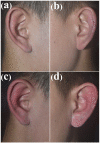Auricular erythermalgia showing excellent response to itraconazole: a case report
- PMID: 35620189
- PMCID: PMC9127843
- DOI: 10.1177/20406223221099335
Auricular erythermalgia showing excellent response to itraconazole: a case report
Abstract
Erythermalgia, a rare painful disorder, is characterized by recurrent pain attacking, warmth, and erythema that mainly involves the distal extremities. Red ear syndrome shares similar clinical features of erythermalgia afflicting the external ear with unilateral/bilateral distribution. The treatments of both diseases are still difficult without controlled therapeutics available up to date. A 12-year-old boy was referred because of 3 years of recurrent attacking of painful erythema and warmth that involved the ears alone, the episodes occurred several times daily with duration of dozens of minutes to hours for each flare. The symptoms could be relieved by cold water and triggered by heat stimuli as well as exciting and movement, and showed mild response to gabapentin, celecoxib, and topical lidocaine compounds in combination, but moderate to blocking injection of botulinum toxin to nervus auricularis magnus. However, systemic itraconazole 200 mg daily resulted in an excellent response after 5-week treatment, leading to milder erythema, warmth and burning sensation, shorter duration, and fewer relapses. The treatment continued for 6 months and then itraconazole was decreased to 100 mg daily for another 6 months until it was stopped, with maintenance of good conditions. In 3 months of follow-up after the treatment ceased, the patient had only 7 to 8 attacks over 10 days presenting as tolerable erythema that lasted for less than 10 min and relieved spontaneously, with absence of warmth and no need of treatment. We considered the patient to be a variant of erythermalgia rather than a red ear syndrome. The results showed that erythermalgia might involve the ears alone and itraconazole might be a potential agent for its treatment.
Keywords: erythermalgia; erythromelalgia; itraconazole; red ear syndrome; treatment.
© The Author(s), 2022.
Conflict of interest statement
Conflict of interest statement: The authors declared no potential conflicts of interest with respect to the research, authorship, and/or publication of this article.
Figures
Similar articles
-
Erythema associated with pain and warmth on face and ears: a variant of erythermalgia or red ear syndrome?J Headache Pain. 2014 Mar 26;15(1):18. doi: 10.1186/1129-2377-15-18. J Headache Pain. 2014. PMID: 24670221 Free PMC article.
-
Recurrent facial erythema with burning sensation and increased temperature: a variant of erythromelalgia or a new entity?Pain Med. 2014 Jun;15(6):1007-10. doi: 10.1111/pme.12343. Epub 2014 Jan 16. Pain Med. 2014. PMID: 24433512
-
Erythermalgia Involving the Face Alone: Two Case Reports.J Oral Facial Pain Headache. 2019 Summer;33(3):e15–e18. doi: 10.11607/ofph.2139. Epub 2019 Apr 24. J Oral Facial Pain Headache. 2019. PMID: 31017985
-
[Classification of erythermalgia].J Mal Vasc. 1996;21(2):80-3. J Mal Vasc. 1996. PMID: 8755186 Review. French.
-
[Familial erythermalgia treated with pizotifen].Ann Dermatol Venereol. 1995;122(11-12):777-9. Ann Dermatol Venereol. 1995. PMID: 8729824 Review. French.
References
-
- Thompson GH, Hahn G, Rang M. Erythromelalgia. Clin Orthop Relat Res 1979; 144: 249–254. - PubMed
-
- Liu JH, Weng ZS, Luo DQ, et al.. Erythermalgia involving the face alone: two case reports. J Oral Facial Pain Headache 2019; 33: e15–e18. - PubMed
-
- Luo DQ, Zhao YK, Xu QF, et al.. Recurrent facial erythema with burning sensation and increased temperature: a variant of erythromelalgia or a new entity? Pain Med 2014; 15: 1007–1010. - PubMed
Publication types
LinkOut - more resources
Full Text Sources


